Controlled proteolysis of normal and pathological prion protein in a microfluidic chip
Abstract
A microreactor for proteinase K (PK)-mediated

* Corresponding authors
a
Université Paris-Sud, JE2495, Protéines et Nanotechnologies en Sciences Séparatives, F-92296 Châtenay-Malabry Cedex, France
E-mail:
myriam.taverna@u-psud.fr
Fax: +33 1 46 83 59 44
Tel: +33 1 46 83 59 03
b
Laboratoire PCC, Institut Curie (UMR CNRS/IC 168), Paris Cedex 05, France
E-mail:
jean-louis.viovy@curie.fr
Fax: +33 1 40 51 06 36
Tel: +33 1 42 34 67 52
c Department of Biological and Biochemical Sciences, University of Pardubice, Nam. Cs Legii 565, 53210 Pardubice, Czech Republic
d Unité de Virologie Immunologie Moléculaires, Institut National de la Recherche Agronomique, 78350 Jouy-en-Josas, France
A microreactor for proteinase K (PK)-mediated

 Please wait while we load your content...
Something went wrong. Try again?
Please wait while we load your content...
Something went wrong. Try again?
A. Le Nel, N. Minc, C. Smadja, M. Slovakova, Z. Bilkova, J. Peyrin, J. Viovy and M. Taverna, Lab Chip, 2008, 8, 294 DOI: 10.1039/B715238H
To request permission to reproduce material from this article, please go to the Copyright Clearance Center request page.
If you are an author contributing to an RSC publication, you do not need to request permission provided correct acknowledgement is given.
If you are the author of this article, you do not need to request permission to reproduce figures and diagrams provided correct acknowledgement is given. If you want to reproduce the whole article in a third-party publication (excluding your thesis/dissertation for which permission is not required) please go to the Copyright Clearance Center request page.
Read more about how to correctly acknowledge RSC content.
 Fetching data from CrossRef.
Fetching data from CrossRef.
This may take some time to load.
Loading related content
